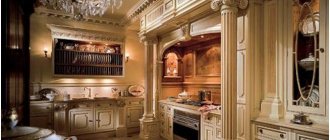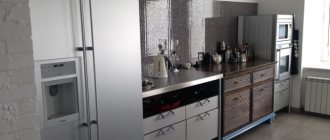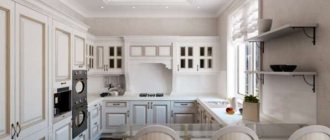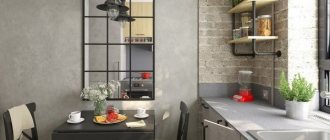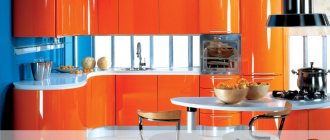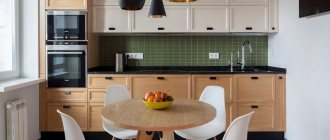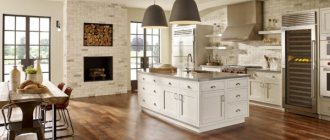Interior features of the East
Oriental style, combining the comfort familiar to Europeans and the originality of the East, is divided into 4 main trends:
- Chinese;
- Japanese;
- Arabic;
- Moroccan.
The first two are Asian style, and the third unites the ethnic interiors of the Islamic states of Arabia. The fourth type is the Moroccan style, containing Arabic and Mediterranean features.
Japanese style kitchen
Asian dishes: 1069 homemade delicious recipes
When they talk about Asian cuisine, they mean a general concept that includes the cuisines of countries such as Japan, China, Korea, Vietnam, Thailand, as well as all the countries of Central Asia. That is, it is not so much a geographical location as the belonging of the local residents to a certain race. And, let’s say, Afghan cuisine is not considered Asian, but rather Arabic. And Turkish will be eastern.
The five most commonly used ingredients in Asian recipes are:
| Product | Calories kcal per 100g | Proteins g per 100g | Fats g per 100g | Carbohydrates g per 100g |
| Sugar | 398 | 0 | 0 | 99.7 |
| Soy sauce | 51 | 6 | 0 | 66.6 |
| Bulb onions | 41 | 1.4 | 0 | 10.4 |
| Carrot | 33 | 1.3 | 0.1 | 6.9 |
| bell pepper | 27 | 1.3 | 0 | 5.7 |
A huge number of Asian recipes differ from each other in many ways. For example, Japanese tends towards greater balance, low use of fats, plenty of fish and rice. But the Kazakh, on the contrary, loves hearty, fatty dishes with a lot of meat: beef, lamb, etc. In Muslim countries there are no recipes with pork - there this meat is considered dirty. But the Chinese actively use this product in their dishes.
This means that there are no specific guidelines by which an Asian dish can be distinguished. It will be necessary to talk about the culinary preferences of a particular country. Thai and Korean cuisines love hot spices - the same can be said about Chinese. In Japan, they love rice - they prepare not only first and second courses with it, but also desserts and alcoholic drinks.
Perhaps we can say that Asian cuisine has a weakness for thick soups: they are eaten in all of the listed countries. Only in each of them they are called differently: lagman, romaine, tom yum, danhuatan, kugigugse, pho. And many first courses include a certain type of noodles: some are homemade, wide and flat, some are rice or egg, round, glass.
Five of the fastest Asian recipes:
| Name of the dish | Cooking time | Calories kcal per 100g | User rating |
| Chinese hot sauce | 5 minutes | 158 | +22 |
| Chinese oyster sauce | 5 minutes | 99 | +7 |
| Spicy sauce | 5 minutes | 240 | +103 |
| Wakame soup | 5 minutes | 20 | +56 |
| Turkish coffee in Turkey | 10 min | 17 | +131 |
An incomplete list of countries (republics, regions) whose cuisines are usually classified as generalized Asian:
Afghanistan, Buryatia, Kazakhstan, Kyrgyzstan, Mongolia, Tajikistan, Tibet, Tuva, Turkmenistan, Uzbekistan; Hong Kong, China, Korea, Macau, Manchuria, Taiwan, Japan; Burma, Brunei, Vietnam, Indonesia, Laos, Malaysia, Singapore, Thailand, Philippines; Bhutan, Nepal.
Chinese style
Along with simplicity and harmony, this style is characterized by a bright palette. Dominant colors are gold and red. Just like the Japanese, the Chinese prefer to use natural materials in the interior. Geometric patterns are often found. Traditional decoration is paintings: landscapes, some scenes, mythical animals. The interior contains screens and cabinets that hide household items.
Chinese style kitchen interior
Asian style kitchen
The beauty of an Asian-style kitchen is tranquility and comfort. Asian style brings a combination of elegant design and a cozy feeling to the home that is ideal for modern homes. Asian style also brings with it notes of mysticism and exoticism, which really attract many. An Asian-style kitchen is imbued with a wonderful sense of thrift, the absence of excess and the use of natural materials - all key ingredients for a traditional lifestyle.
The amazing thing about Asian kitchens is that they pretty much fit into any home and become a natural extension of any other design style, be it minimalist or traditional.
Asian design aims to create the perfect balance, especially in terms of the materials used or the variety of colors and shades that are present in the kitchen. All visual elements must be in perfect balance. The best way to achieve balance is to use calming natural tones along with some darker shades to achieve the perfect combination. This is possible if you make custom kitchens.
The same can be said about the materials used: natural wood, stone, bamboo, present in the creation of the interior and perfectly combined. The ideal Asian kitchen design is achieved through the perfect harmony of casual aesthetics and elegant ergonomics.
The most important aspect of Asian interior design is achieving a sense of harmony, which reflects not only human relationships, but also unity with the surrounding world and nature. It's quite difficult. Using bamboo or any other green plants on these smooth surfaces gives your Asian-style kitchen a more natural, harmonious look. Try using bamboo shelves and eco-friendly wood elements to give your kitchen a truly oriental feel that goes beyond cosmetic appearance and additions.
A touch of glass, shiny surfaces and similar stylized panels, cabinets, concrete and natural tones that combine with an earthy base are exceptionally suitable for giving a special Asian atmosphere to the kitchen. A natural extension of this design is minimalism and, therefore, you will always be comfortable here, and it will never look too colorful. Most Asian style kitchens are ergonomic, sleek and ideal for stylish modern homes and apartments.
You can also add some bright colors here to liven things up a bit. In addition to natural green, you can also use golden yellow or red colors in different parts and elements, which will be completely in Asian style.
Arabic style in oriental style
The cornerstone of Arabic interior design is religion. Everything here meets the requirements of the revered book - the Koran, which imposes a taboo on drawing representatives of the animal world and people. Ornaments are only geometric and floral.
The role of partitions is given to weightless, delicate curtains. This style is characterized by luxury, rich decoration, emphasizing the solid state of the owner in social and financial terms.
Arabic kitchen design
Traditionally, the design includes painted surfaces. Convex trim elements are plated with gold, and the rest is painted red or blue. This artistic technique brings amazing depth to the interior.
Standard furniture, as for a European, is replaced with carpets, pillows, and low sofas. This is explained simply: it is difficult to grow wood in hot climates, so it is irrational to make kitchen furniture from it.
Interior in Moroccan style
A feature of the design is the presence of metal decorations, forged grilles on small-width lancet windows, carved elements and inlays on furniture, embossing and carvings as decoration. The dominant features of Moroccan design:
- ornaments - geometric, floral;
- fabrics - high-quality, luxurious;
- lots of textiles;
- ceramics on the floor;
Kitchen in Moroccan style
- basic colors - white, blue, terracotta;
- narrow and high windows.
The main direction is to create a feeling of spaciousness, calm, peace and coolness.
Asian cuisine: recipes, features
Delicious Asian dishes have become especially popular lately. This is explained by the fact that oriental cuisine is both nutritious and low in calories. And there are many people who want to try exotic things. Take Asian noodle dishes, for example. They are amazing in any design. The same can be said about Asian soups. You can find recipes for various oriental dishes on the CookLikeMary website. Try to cook Asian first courses once in your life, as you will probably want to repeat your experiment.
The main dish is served with a large portion of rice with meat, fish, and vegetables. And sauce must be added to them.
For those who keep their figure or are on diets, we are happy to offer noodles with seafood, rice with turkey, and Asian salads. Their recipes are completely simple to prepare. A dish of seaweed and vegetables is ideal as a snack. Particularly popular are tempura appetizers, deep-fried vegetables, battered fish, and seafood. Such dishes are served on huge bamboo skewers.
Asian dishes can be found from thousands of others:
- they are characterized by spiciness, because a large number of seasonings are added to them;
- they are low in fat;
- prepared from soy products, fish, seafood, seaweed, chicken, turkey;
- Pork and lamb are considered uncharacteristic products; Asian dishes made from this meat are rare;
- A popular cooking method is frying in boiling oil;
- noodles, rice, legumes are the most common foods;
- vegetables are cooked over high heat, which preserves vitamins and nutrients;
- Asian sauces, the recipes of which are known to few, are the highlight of oriental cuisine; they give dishes a piquant taste and a unique aroma.
Another difference in Asian cuisine is yeast-free bread.
Kitchen decoration
Plaster, paint, and wallpaper are used to decorate the walls, so the walls need to be smooth. Each of the directions has its own design features:
- Background Asian interior does not come to the fore, there is no variegation and luxury in it, but high demands are placed on the quality of materials. In order to decorate a kitchen in Chinese or Japanese style, the walls are painted. The oriental flavor is given out by the solid wooden beams on the ceiling.
Beams on the ceiling highlight the Asian style
- an Arabic-style kitchen has brighter colors. Fabrics, wallpaper, and traditional painting are used to decorate the walls. Wallpaper with wide expressive stripes and gilded edges is the best option for Moroccan design.
- The floor , depending on the style direction, is made of laminate, natural wood, ceramic tiles, taking into account the color spectrum established by tradition.
- European ones are not suitable for cuisine in oriental traditions. windows and swing doors. The first ones are distinguished by a specific frame design and unusual glass layout. Folding or carved shutters are typical. Instead of a doorway, they use wooden lathing, sliding partitions, and decorate them with stained glass, patterned glass, and rice paper.
In Japanese interiors, doors are most often sliding
- ceiling, traditional for the oriental style , is plastered or painted, complemented with decorative elements: carved frieze, beams, artistic painting.
- The color is selected taking into account ethnic characteristics:
- calm, warm, pale tones with dark elements for Japanese design;
- red and gold colors to create a Chinese interior;
- rich, bright versions of red, blue, gold, green, orange in the Arabic interior.
Attention! According to Feng Shui, a kitchen designed in the Chinese style must have: red - “the color of good luck”; yellow - “imperial”; blue - “the color of the nobility.”
Furniture
Furniture in oriental style has its own ethnic identity. But richly decorated furniture in the Arabic style will be expensive, because... involves the use of natural materials in production and a complex, labor-intensive decorating process. Moreover, it is not necessary to use oriental motifs in everything. To create an eclectic interior, a classic kitchen set with panels is suitable.
The dining area can become just that atmospheric place where you can create the mood of a real Arabian fairy tale. A luxurious tablecloth, soft sofas with cushions, a lamp with a lampshade suspended above the table will definitely cope with the task.
For the dining area, a massive carved table, pouf stools or stools with carved legs and a soft seat are suitable. If the kitchen is large, then an excellent solution would be a sofa with armchairs with a back, covered with velvet or brocade fabric.
Furniture selection
The result of efforts to decorate an oriental kitchen depends on the choice of kitchen furniture. Ideally, it is made of solid wood and has laconic shapes.
- In Chinese and Japanese interiors there is light furniture with dark elements with strict geometry.
- The Arabic style presupposes the presence of dark furniture made of expensive wood or a high-quality substitute. The facades are decorated with stained glass, inserts - in the form of a lattice or wicker, chased parts, forged fittings made of copper or bronze.
There are no open shelves in oriental kitchen design
- The dining table is certainly large, surrounded by half-chairs or chairs.
- Cabinets, shelves with doors only. Everything unnecessary should be hidden.
- The stove and oven are a symbolic hearth, so they select a large-volume oven, a multi-burner stove, and a high-quality, expensive range hood. Special attention is paid to the arrangement of the cooking area: they decorate the wall near the stove with mirrors, place copper utensils, and collectible knives.
Advice: it is better to zone a large kitchen, allocating a place for work, dining, and relaxation. The last zone is raised to the podium, sofas, pillows, and low tables are placed there.
By decorating your kitchen in the “East” style, you will find a place for relaxation and get the opportunity to come into contact with the fabulous oriental magic. The main thing is not to forget about a sense of proportion.
Living in unity with nature
The main aspect is harmony not only between people, but also with the surrounding world. This has always been part of the culture of eastern countries and is reflected in design. Live plants on the counter will give the room an authentic look.
White oak furniture
Strict outlines and muted colors
Zen style
Cabinets made from natural materials and green color bring with them the flavor of Asia
Dark countertops and light doors
Pendant-shaped lamps and smooth lines
